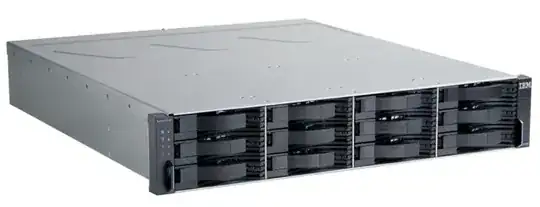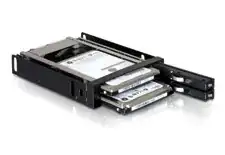It's easy to look at pictures of hard drive caddies and storage arrays but that isn't going to help. As I'm sure you know, it's not just about getting a large amount of disks and throwing them into a rack - you need to think about how they will be accessed, monitored, controlled, etc. I'm also a little confused - in your question title you talk about "many" hard drives and in the detail you talk about 4 drives - do you literally mean 4 drives, or do you mean 4 drive chassis of the sort in your picture?
The most "economical way of getting lots of disk into a rack mount" is difficult to answer because what that actually means changes depending on the problem you're trying to solve. You need to define what you're going to use them for, what sort of risks are acceptable to you and how you define "economical". And while you might have a tight budget, which is fine, you need to accept there will be some real costs here, either in time or money if not both.
What sort of problem are you trying to solve
In other words, what do you want to do with the disks, how will they connect to the thing(s) you want to use them with, etc. Different types of storage are suited to different types of job - broadly speaking you can divide "a bunch of disks in a rack" into 3 broad categories depending on what they are connected to (there are lots of other ways to group this and break it down, of course)
Direct Attached storage - DAS for short.
This is a dedicated storage array that plugs directly into an already existing server to expand the storage available on that server, usually via either SCSI, (more recently) SAS, or (typically at the lower end) SATA. This will give you a reasonably economical way of providing a lot of storage to one machine. That one machine might then act as a file server and publish shares on your network to contain files, and you can even find software to turn this hypothetical server into a NAS (see openfiler or FreeNAS for examples) or SAN (openfiler is an obvious example).
Network Attached Storage - NAS for short
A NAS is essentially a minimalistic server that is dedicated to providing shared storage on a network. Typically this will be an appliance with a highly tuned OS and file system, designed to publish fileshares on a network with reasonable performance and security, and not do a lot else (though many home/small office NASes do other tricks as well).
If you're trying to provide bulk "network" storage, perhaps centralised storage for office workers to store documents, or even for their workstations to be backed up to a central point this can be a good bet. You will probably find that a NAS might cost more than a DAS solution, but then you don't also have to provide a server and spend time configuring the server as a file server. You pays your money and you takes your choice. There are some cheap NAS devices out there (like this one) but once you start talking about rack mountable devices you're talking about "enterprise computing" and the prices and features start going up accordingly.
Storage Area Network - SAN for short
A SAN is a more specialised network file store, which is designed to allow its storage to be divided between several servers and viewed "logically" on each server as if it were a local direct attached/internal device.
SANs are connected to the servers using them by a "network" that is usually (but not always) dedicated to the SAN connections to ensure both good security, reliability and performance.
SAN infrastructure and disk typically ranges from "quite expensive" to "Is that really a price, or an international phone number" so with your worries about budget you probably see this outside of your price range - though depending on your requirements it may turn out this is what you need, in which case you may be able to set one up for "free" using the resources I suggest above.
Risk, and how you define "economical"
You mention a NAS that supports RAID as being out of your price range in your question, but you need to think about risk - only you can define what chances you are prepared to take with your data and how valuable it is, but you need to be aware that the more disks you have in a storage array, the greater the chances that one will fail and the greater the chances that another will fail while the first one has not yet been replaced and brought back online. There's a discussion about this here.
This bring us to "economical" - do you consider this to mean you want the cheapest possible solution, period (which will probably be a server with a lot of DAS boxes, configured in one giant RAID 5 array) and damn the problems and risks this might bring? Or do you consider "economical" to mean "good value for money" (which isn't always the same as 'cheapest'). I'm a lot more comfortable with that second definition myself.
Other considerations
If you want a rack full of hard drives, then you need to be aware that this will require a good power supply and will also generate a lot of heat which will need to be removed/cooled in order to keep the hard disks operating reliably, so air conditioning and careful planning of rack air-flow and power needs may be a requirement.
 I've also found these type of cute adapters that takes two 2.5" drives in one 3.5" slot, but I will obviously need a chassie with a lot of 3.5" spaces in order to make it work.
I've also found these type of cute adapters that takes two 2.5" drives in one 3.5" slot, but I will obviously need a chassie with a lot of 3.5" spaces in order to make it work.